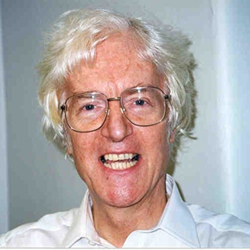
Your complimentary articles
You’ve read one of your four complimentary articles for this month.
You can read four articles free per month. To have complete access to the thousands of philosophy articles on this site, please
Articles
“Will the real Mr Bowie please stand up?”
Stefán Snævarr explores Derek Parfit’s ideas about the self, and how they might apply to the complex (of) personalities of David Bowie.
David Bowie (1947-2016) was a man of many faces, even many selves. He was baptized David Robert Jones, but changed his name and his self by becoming David Bowie. Then Bowie adopted the personas of Ziggy Stardust, Aladdin Sane, The Thin White Duke, and so on. In his song ‘D.J.’ from the album Lodger, Bowie sings “I am a D.J., I am what I play.” Contemplating Bowie’s life raises a number of philosophical questions concerning the self. Are we what we do, as he hints at in ‘D.J.’ and as Jean-Paul Sartre said explicitly? Can we be the authors of our selves, as Friedrich Nietzsche and Michel Foucault maintained? Did David Jones truly recreate himself as David Bowie? Did David Bowie in his turn recreate himself as Ziggy Stardust? And do Aladdin Sane’s multiple personalities include those of Bowie, Ziggy and the elusive Mr Jones? Will the real Mr Jones please stand up?
In this article, I will focus on Oxford philosophy professor Derek Parfit’s analysis of the self in his book Reasons and Persons (1984). I’ll begin by giving a short explanation of his approach, then proceed to critique it. I’ll put forth some critical arguments of my own, then discuss criticisms of Parfit made by Paul Ricœur and Marya Schechtman criticisms of Parfit.
Parfit’s Continuity

David Parfit RIP
Born in 1942, Parfit, who died on New Year’s Day, was a British philosopher of the same generation as Bowie. They evidently shared an interest in the questions of selves and identities.
In Reasons and Persons, Parfit argues that it isn’t true that every human individual must possess one and only one self which persists through his or her (adult?) life-time. He also tries to show that the concept of personal identity is empty. To vindicate these theories, he conducts some mind-blowing thought experiments of the science fiction kind. Let’s take a look at Parfit’s ‘My Division’ thought experiment (pp.253-266). Suppose I am one of identical triplets. My brain is surgically removed and divided into two halves. Each half is transplanted into each of my brothers, who have had their own brains removed to make room for mine. Both the resulting persons remembers my life, has my personality, is psychologically continuous with me, and believes that he is me. Now, what has happened to the ‘real’ me?
There are only four possibilities:
1) I do not survive;
2) I survive as one of the two people;
3) I survive as the other person;
4) I survive as both.
The objection to 1) is that I would survive if just one half of my brain had been successfully transplanted. People are known to have survived even though half of their brains were destroyed.
The last possibility is not a coherent option, since the logic of identity – that a thing is itself and not two things – excludes the possibility of there being two things that are both identical with one original thing, me. By the same token, it does not really make sense to say that either 2) or 3) are true, since both surviving brothers are exactly like me – are me for all intents and purposes.
Parfit argues that this thought experiment and its possibilities show that identity in the logical sense is not what matters for the self. What matters here is psychological continuity: if the resulting person is sufficiently strongly psychologically connected to me as I was before the transplantation, then it makes sense to say that the resulting person is me: not necessarily that the resulting person is identical with me, rather that there are enough overlapping psychological facts about me and that later person to say that they’re continuous with me. We might for instance share a host of memories. More precisely, for psychological continuity, there must be what Parfit calls ‘strong connectedness’ between the current me and a past person. He says we have a case of strong connectedness when at least half the number of psychological attributes that hold at any give time for a given individual are maintained at a later time. This would be true for someone when asleep and when he wakes, for instance. Continuous personal identity over a lifetime is then defined in terms of overlapping chains of strong connectedness. Moreover, a person at a given time is either strongly connected to a person who existed earlier, or is not. There is no middle ground. Furthermore, personal identity is an all-or-nothing relation: either Adam and Brian are the same person, or they are not.
Let us assume then that Adam’s brain-halves are transplanted into the bodies of Brian and Charlie. Then, given psychological continuity, both Brian and Charlie are identical with Adam. However, Brian and Charlie are not identical with each other.
Doesn’t the non-identicalness of Brian and Charlie create problems for the psychological continuity view? Parfit tries to avoid the problem by modifying the definition of identity. He maintains that personal identity is constituted by non-branching psychological continuity, such that Adam is the same person as Brian only if Adam is psychologically continuous with Brian and nobody else. In other words, if Adam is psychologically continuous with both Brian and Charlie, and Brian and Charlie are distinct, then Adam is not the same person as either Brian or Charlie.
To explain his ideas, Parfit uses clubs as an analogy to selves. Let’s assume that a certain club disbands, but later a few of its members reconvene. Is it the same club? The question has no definitive answer. Since a club’s being that club depends on more basic facts, concerning for instance the activities of its members, there is no fact of the matter about whether it is the same club. In other words, the question of identity is not the main question here. As long as we know all the facts about who is meeting, where, when and why, we know everything that we need to know about the club. If we still felt that there must be some deep fact that determined club identity, then we would be disturbed by our inability to give a clear-cut answer to the question. Parfit’s point is that the identity of persons is similar to the identity of clubs, and cannot have a definitive, clear-cut answer. In the transplantation case, he says that the original person survives as both of the resulting persons, but is identical to neither.
Multiplying The Self
Parfit maintains not only that it is logically possibly that we can change selves during our lifetime, but also that it’s logically possible that people can have simultaneous multiple selves (if it makes sense on his view to say that we have selves). So David Jones could have changed self from David Bowie to Ziggy Stardust; and Ziggy Stardust could have had the self of both David Jones and David Bowie at the same time.
Parfit further says that it is logically possible not only that selves can divide, but that two selves can merge into one – if, for instance, two halves from different brains were fused into one brain. Note however the caveat about logical, that is, theoretical, possibility. He is not saying that this could happen in the real world. Despite this, he notes that there have been split-brain cases where people report that another person is inside their head with them, and these erstwhile split-brain individuals do act as if they were two persons. Perhaps Aladdin Sane was such a split personality. In the Seventies TV documentary/interview, Cracked Actor, Mr Bowie said that Mr Sane had many personalities.
Parfit’s view of the changing self has both moral and existential ramifications. It means we should not worry too much about the future, because our current selves will not be around then. Similarily, we should not brood about past mistakes, as they were made by other selves. It also means the giving-up of egoism, not just because there is no such thing as our continuous ego, but also because we have no more reason to care more about our future selves than about the selves of other people now or later. As Parfit emphasizes (pp.281-282), this is in accordance with Zen Buddhist views. Parfit approvingly discusses the Buddhist view that the self is in some ways a fiction, and that understanding this is the way to enlightenment.

A line of various Bowies, from various album covers
Surgical Complications
One might reasonably ask whether such wildly speculative examples as Parfit’s My Division thought experiment can have any bearing on anything. What exactly is proven by their use? What if brain-transplantation and teleportation turn out to be practical impossibilities? Wouldn’t that undercut his arguments? Also, such examples as Parfit uses can only be used to generate theories given certain intuitions. However, most of us have the intuition that we have a continuous identity and one self. So why should Parfit privilege his intuitions due his outlandish examples over the intuition most people have that they possess continuous identity and one self?
Furthermore, wasn’t David Bowie’s creation of different characters just a playing with ideas? Wasn’t David himself simply someone with one self – that of David Jones? To be sure, he said in the Cracked Actor interview that there are moments when he’s not quite sure whether he’s himself or one of his creations; but that might just have been some kind of delusion or joke. Perhaps it was only wishful thinking or poetic exaggeration when he sang “Gonna have to be a different man” (from the song ‘Changes’ on the album Hunky Dory). Maybe we are simply stuck with one given identity and one self, even if we might sincerely wish to be different, to change our identities and selves.
Be that as it may, Parfit’s conclusion to the My Division thought experiment makes sense on a radically materialist view. This is the view that matter, its configurations and movements, is all there is. If the self is but a function of material configurations, then copying and dividing these configurations, and by implication dividing the self, is surely logically possible. But suppose instead that the self is a mental entity, albeit tied to the body through the brain. If that’s the case, then the My Division thought experiment would not necessarily tell us anything about the nature of the self.
I do not exclude the possibility of radical materialism being true. The trouble is that we do not have any conclusive evidence in favour of this idea. Indeed, does it make sense to look for empirical evidence supporting radical materialism? If ‘Yes’, what kind of evidence would we be talking about? And even if that question could be usefully answered, empirical evidence is fallible, so we cannot look for conclusive empirical evidence in favour of radical materialism.
What about analytical (that is, purely theoretical) necessities? The statement ‘the only thing that exists is matter’ is definitely not an analytically true statement – that is, it is not true simply in virtue of its meaning, as the statement ‘two plus two equals four’ is – since it can be negated without logical inconsistency: ‘It is not true that only matter exists’ is also a meaningful statement. Of course, this might be an over-simplification, and to show that materialism is theoretically necessary we might need a complex analysis of the Parfitian kind. However, the onus is on those who maintain that such an analysis is possible to demonstrate the theoretical necessity of materialism.
Maybe the theory that matter is all there is can be justified as an inference to the best explanation of our experience of the world, from the fact that the continuity of most of our sense-impressions seems to be rooted in the mind-independent existence of material objects? Say the cheese in the larder has disappeared. Last night scratching sounds were heard from the larder. There have also been sightings of mice recently. The inference to the best explanation here, given this evidence, is that mice ate the cheese. Similarily, I repeatedly see some colours, a given shape, and experience a certain substantiality, when I am using my kettle. The best explanation of the stability of these sense-impressions may be that they stem from a concrete, stable, material object – the kettle that generates them. (See Samir Okasha, Philosophy of Science: A Very Short Introduction, pp.29-33, 2002.) However, even if postulating the existence of material objects is the best explanation of the stability of our sense-impressions, it does not follow that radical materialism can be vindicated by this, as there may be minds as well as matter. Again, the burden of proof is on whomever claims materialism follows from this. The upshot is that we do not have any compelling reasons to take a radical materialist interpretation of the My Division example, which would make its conclusions viable.
Nevertheless, there might be a viable version of the My Division example. If, as Parfit assumes, psychological continuity, not bodily (that is, brain) continuity, is what matters for personal continuity, then we could think the self is an immaterial psychological entity, and perhaps this entity could divide in a similar way to bodies without any material processes being involved.
One problem is that we can easily imagine how material configurations can divide, but can we fathom the division of something mental? Further, we have hardly any empirical evidence in favour of the contention that there are mental entities. In addition, no logically necessary truths are involved in positing their existence, since statements such as ‘There are mental entities distinct from material entities’ can be coherently contradicted too: ‘There are no mental entities distinct from material entities’ is also a meaningful statement.

Further Divisions Over My Division
The late French philosopher Paul Ricœur quite correctly said that Parfit just assumes without argument that the self should be analysed as an isolated phenomenon which might or might not exist. Questions such as ‘Could the self be essentially a social phenomenon?’ are not even raised by Parfit. For instance, maybe Bowie’s self was irreducibly part of the society and culture in which he acted. But maybe the self is irreducibly a social phenomenon (see Ricœur’s Oneself as Another, pp.130-139, 1992). In that case Parfit would be dead wrong.
Parfit’s arguments concerning strong connectedness are also not impressive. How does one measure strong connectedness or count psychological attributes? If there are unclear boundaries between two or more, how should they be counted? Why do half of the connections have to hold, as he claimed, rather than 75%, or 45%? This smacks of arbitrariness, as American philosopher Marya Schechtman indeed points out in The Constitution of Selves (pp.43-44, 1996). There she asks us to imagine that her present person-stage is connected to a previous one by exactly half the connections that hold every day in the lives of nearly every person. If there are overlapping chains of such connectedness going back to the person-stage who was there ten minutes ago, then she’s the same person she was ten minutes ago. Now let us assume that in the next moment one connection is lost, without a new one being added. On Parfit’s view, there is no longer strong connectness between the present person-stage of Marya Schechtman and the one of ten minutes ago. But it also means that Marya Schechtman, who was sitting here for the previous ten minutes, has vanished! There’s something deeply counterintuitive about this. It’s also inconsistent, since because she has only lost some connections with who she was a few moments ago, she also is the same person as she was a few moments ago!
The same counterintuitiveness holds for Parfit’s ‘non-branching’ concept. Schechtman points out that it flies in the face of common sense to believe that Adam and Brian might be the same person if Charlie does not exist, but not the same person if Charlie does exist, despite no other facts about Adam and Brian being altered by the fact of Charlie’s existence.
For these and various other reasons, Schechtman wants to replace Parfit’s psychological continuity view with a theory that focuses on what kind of characteristics a given self has. So instead of saying that we know who Adam is if and only if we know there is non-branching psychological continuity between Adam at one time, and Adam later, we say that we can recognise Adam again later because we know the characteristics Adam has. (To be sure, re-identification is of great importance when we’re trying to work out whether Ziggy Stardust is the same person as David Bowie.) Schechtman says the answers to such questions largely concern not psychological but corporeal continuity: we recognise bodies before we recognise minds. The psychological dimension is of greater importance when we have the sort of identity crises that lead us to ask “Who am I, really?” In such contexts we focus on ourselves as subjects and refer to the psychological characteristics we do or don’t possess.
Identification via character refers to the set of personality traits that each person has which make her the person she is. To understand this identity, one must know not only which characteristics form part of a person’s history, but the role of these characteristics in that history. One must also know which of the characteristics are central to the person – which of them she regards as part of her true identity – and which not. But what does it mean to say that some particular characteristics are those of a given person – for instance, what characteristics are really hers, and not, say, the result of brainwashing, or even other external influences, such as education? How can we tell which of her actions, thoughts and experiences are really in character, and which are less so, or even not so? What thoughts and character traits really do belong to her? The question of what traits are mine seems important, perhaps because by them we can tell which actions I’m really responsible for.
There certainly was corporeal continuity between David Bowie, Ziggy Stardust, and Aladdin Sane; but to complicate matters, one of Bowie’s central psychological characteristics was his unique imagination, manifest in, among other things, his ability to invent characters and put on new personas.

Conclusion
Parfit maintains that it is not logically necessary that each individual has one given self: it is not unthinkable that more than one self can inhabit the same body, that selves are divisible, or that selves can merge, and that in some sense, the self is an illusion. To make his case he uses scenarios such as My Division. But he has not succeeded in showing that the example is viable, let alone that it yields necessary conclusions. His thinking seems to presuppose materialism, and materialism can hardly be proven to be true, either logically or empirically. His arguments could perhaps be given a dualist twist, but proving dualism is just as difficult as proving materialism. To make matters worse, Parfit does not show that his speculative science fiction examples have any bearing for the truth of real-world matters of the self. Why should our intuition that we possess one self be less reliable than his intuitions based on his far-fetched examples? Furthermore, as Ricœur points out, Parfit ignores the possibility of the self being essentially social; and Schechtman puts forth forceful arguments against Parfit’s view that a self is really only a case of psychological continuity, and that the identities do not matter. Knowing a self is not only a matter of physical reidentification, but also of knowing its characteristics.
It certainly does matter to any Bowie fan whether or not Mr Stardust was identical with The Thin White Duke.
© Prof. Stefán Snævarr 2017
Stefán Snævarr is professor of philosophy at the Inland Norway University of Applied Sciences.









